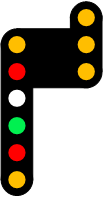
 |
French Railway Signals |
Apart from having the most elegant signal heads (I expect no different from our neighbours), French railway signals have some unique characteristics regarding aspects and terminology.
Somewhere I have read that French was chosen as language for international diplomacy for its clarity and ability to express slightest nuances. Consistently with that, French have invented the signalling system that has the largest number of different ways of indicating arrêt (stop).
For this, I have divided this section into three pages:
a
page about the stop aspects
a
page about the proceed aspects
and the current page, which you should read because it explains a
little of the
terminology used. To understand the colour signal aspects, we need to
look into the
mechanical signals and a little into the various block systems used in
France. It is also
important to note that French signals, unlike e.g. German signals, are
not distinguished
by their validity for train or shunting movements, but by the things
they are guarding
(i.e. blocks, danger points, train routes, shunting tracks etc.)
 |
As in many
other countries, France used semaphores to protect train movements.
When in the horizontal position, French semaphores show stop. To show
'clear' (voie libre), the bar is rotated
counter-clockwise into the vertical position.
However, semaphores are used only to protect blocks, and
the stop aspect therefore usually is permissive (depending on the block
system, the stop aspect may also be absolute). |
 |
To indicate an
absolute stop at signals that are protecting things like danger points,
tunnels, set train routes in stations, long blocks on the wrong line,
catenary sections etc., France used red-and-white square boards. This
board always indicates an absolute stop, i.e. stop and stay. To indicate a proceed aspect, the board is horizontally flipped edge-on. The French word for square is carré, and so an absolute stop aspect is called carré - even when displayed by a color light signal. |
 |
On shunting and
service tracks, an absolute stop is indicated by a violet carré,
or called carré
violet in French. This is also an absolute stop. |
So what we have learned from this is that in France you have colour light signals that can show sémaphore and carré. Loosely speaking, you could call these aspects 'block stop' (permissive) and absolute stop. On shunting and service tracks, an absolute stop may be indicated by a carré violet ('violet square').
To complete our knowledge about French terminology, I will introduce the 'Warning' and 'Disk' signals.
 |
As mechanical distant signal, France uses a yellow diamond with a white border to indicate 'expect stop'. In French that is called avertissement - warning. To indicate 'expect clear', the board is flipped edge-on (very similar to a German Vorsignal). |
 |
On lines with
low traffic, an entry into a station may be protected by a disc
(French: disque). A disque means that the driver
has to slow down, proceed on sight after the disque and to stop in
front of the first points or at the following signal box. Then wait until given verbal permission to proceed. |
As I am mainly talking about the signal aspects on this site, I won't go too deep into the details of French block systems. But if a main signal shows stop, the required action is determined by the block system. Similar to Germany, in France post plates are used, but unlike German post plates which are using colours, French post plates are all black with white reflective letters which indicate the block type.
| absolute stop: stop and stay | |
 |
Non
Franchissable - Not Passable This is a Carré signal which may protect a danger point, tunnel, long blocks on the wrong line etc. If the signal shows carré (stop) or is out of order, passing is forbidden unless by written order. |
 |
Block Manuel -
Manual Block Stop and stay, unless by written permission. |
| permissive stop: stop and proceed on sight | |
 |
Franchissable -
Passable This is an automatic block signal. Can be passed by shunting movements not exceeding 15 km/h. Proceed on sight until the next main signal, level crossing or signal box. |
 |
Block
Automatique à Permissivité Restreinte (BAPR) -
Restricted Permissive Block Used on long blocks to avoid driving on sight for longer distances. Stop and get permission from signalman. If unable to contact signalman, wait for 15 minutes, then proceed on sight. |
 Home Home |
 foreign signals foreign signals |
 email email |
 stop aspects stop aspects |